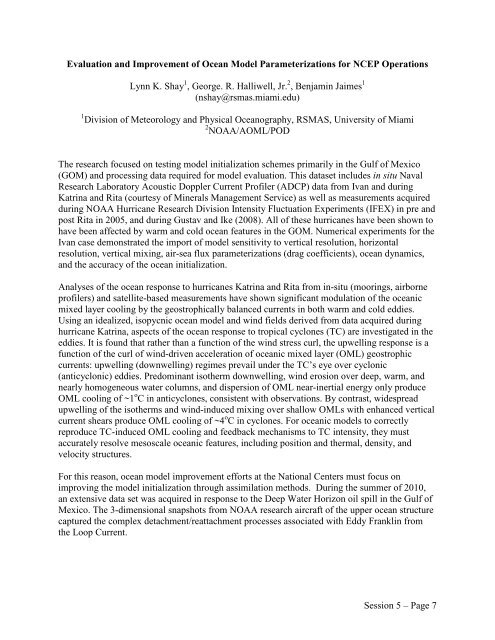65th IHC Booklet/Program (pdf - 4.9MB) - Office of the Federal ...
65th IHC Booklet/Program (pdf - 4.9MB) - Office of the Federal ...
65th IHC Booklet/Program (pdf - 4.9MB) - Office of the Federal ...
You also want an ePaper? Increase the reach of your titles
YUMPU automatically turns print PDFs into web optimized ePapers that Google loves.
Evaluation and Improvement <strong>of</strong> Ocean Model Parameterizations for NCEP Operations<br />
Lynn K. Shay 1 , George. R. Halliwell, Jr. 2 , Benjamin Jaimes 1<br />
(nshay@rsmas.miami.edu)<br />
1 Division <strong>of</strong> Meteorology and Physical Oceanography, RSMAS, University <strong>of</strong> Miami<br />
2 NOAA/AOML/POD<br />
The research focused on testing model initialization schemes primarily in <strong>the</strong> Gulf <strong>of</strong> Mexico<br />
(GOM) and processing data required for model evaluation. This dataset includes in situ Naval<br />
Research Laboratory Acoustic Doppler Current Pr<strong>of</strong>iler (ADCP) data from Ivan and during<br />
Katrina and Rita (courtesy <strong>of</strong> Minerals Management Service) as well as measurements acquired<br />
during NOAA Hurricane Research Division Intensity Fluctuation Experiments (IFEX) in pre and<br />
post Rita in 2005, and during Gustav and Ike (2008). All <strong>of</strong> <strong>the</strong>se hurricanes have been shown to<br />
have been affected by warm and cold ocean features in <strong>the</strong> GOM. Numerical experiments for <strong>the</strong><br />
Ivan case demonstrated <strong>the</strong> import <strong>of</strong> model sensitivity to vertical resolution, horizontal<br />
resolution, vertical mixing, air-sea flux parameterizations (drag coefficients), ocean dynamics,<br />
and <strong>the</strong> accuracy <strong>of</strong> <strong>the</strong> ocean initialization.<br />
Analyses <strong>of</strong> <strong>the</strong> ocean response to hurricanes Katrina and Rita from in-situ (moorings, airborne<br />
pr<strong>of</strong>ilers) and satellite-based measurements have shown significant modulation <strong>of</strong> <strong>the</strong> oceanic<br />
mixed layer cooling by <strong>the</strong> geostrophically balanced currents in both warm and cold eddies.<br />
Using an idealized, isopycnic ocean model and wind fields derived from data acquired during<br />
hurricane Katrina, aspects <strong>of</strong> <strong>the</strong> ocean response to tropical cyclones (TC) are investigated in <strong>the</strong><br />
eddies. It is found that ra<strong>the</strong>r than a function <strong>of</strong> <strong>the</strong> wind stress curl, <strong>the</strong> upwelling response is a<br />
function <strong>of</strong> <strong>the</strong> curl <strong>of</strong> wind-driven acceleration <strong>of</strong> oceanic mixed layer (OML) geostrophic<br />
currents: upwelling (downwelling) regimes prevail under <strong>the</strong> TC’s eye over cyclonic<br />
(anticyclonic) eddies. Predominant iso<strong>the</strong>rm downwelling, wind erosion over deep, warm, and<br />
nearly homogeneous water columns, and dispersion <strong>of</strong> OML near-inertial energy only produce<br />
OML cooling <strong>of</strong> ~1 o C in anticyclones, consistent with observations. By contrast, widespread<br />
upwelling <strong>of</strong> <strong>the</strong> iso<strong>the</strong>rms and wind-induced mixing over shallow OMLs with enhanced vertical<br />
current shears produce OML cooling <strong>of</strong> ~4 o C in cyclones. For oceanic models to correctly<br />
reproduce TC-induced OML cooling and feedback mechanisms to TC intensity, <strong>the</strong>y must<br />
accurately resolve mesoscale oceanic features, including position and <strong>the</strong>rmal, density, and<br />
velocity structures.<br />
For this reason, ocean model improvement efforts at <strong>the</strong> National Centers must focus on<br />
improving <strong>the</strong> model initialization through assimilation methods. During <strong>the</strong> summer <strong>of</strong> 2010,<br />
an extensive data set was acquired in response to <strong>the</strong> Deep Water Horizon oil spill in <strong>the</strong> Gulf <strong>of</strong><br />
Mexico. The 3-dimensional snapshots from NOAA research aircraft <strong>of</strong> <strong>the</strong> upper ocean structure<br />
captured <strong>the</strong> complex detachment/reattachment processes associated with Eddy Franklin from<br />
<strong>the</strong> Loop Current.<br />
Session 5 – Page 7
















